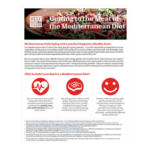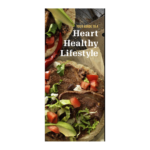The Nuts and Beef of a Mediterranean Dietary Pattern

Written by Hawley Poinsett, MS, RDN, LD
Consuming a Mediterranean-style eating pattern is consistently associated with a reduced risk of developing cardiovascular disease.1 US News and World Report annual ratings2, American Heart Association3, Academy of Nutrition and Dietetics4 and countless other health organizations refer to the Mediterranean Diet as one of the healthiest choices for individuals for everything from general healthy eating to managing complex disease states such as cardiovascular disease. The Mediterranean Diet can be described as being rich in fruits, vegetables, whole grains, nuts and seeds, and olive oil. As practitioners, if the recommendation is “The Mediterranean Diet”, what do patients translate that into? If no context is given, they likely think they need to eat at a Greek restaurant to be compliant. Patients may have heard it is plant-based, or they translate it to mean that they need to add a tablespoon of polyunsaturated oils to their diet each day. It is crucial that health professionals translate recommendations and research studies into actual real-life meals that taste good, are affordable and frankly are realistic to incorporate into the every-week rotation. In order to do that, a health educator must have an understanding of the dietary pattern itself, the research behind it, and a firm understanding of the needs and abilities of the patient at the time.
Let’s dig into what a Mediterranean dietary pattern really means.
First, it is important to clarify what a dietary pattern actually is. It is not a meal plan or a calculation of macros at each meal. In fact, it is a way of eating that can and should be adapted to the individual and the family. It can look a lot of different ways. In order to determine the Mediterranean Dietary Pattern that works for each patient, it is important to first understand what the research says and second, to do a little investigation with the patient on what their likes and dislikes are, what their life is really like day-to-day, and to be a facilitator in finding out their “why”.
What does the science say?
The origins of the Mediterranean dietary pattern are based on traditional foods from countries that surround the Mediterranean Sea. Ancel Keys’ Seven Countries Study observed the diets of Southern Greek Olive Farmers due to the observance of incredibly low rates of cardiovascular disease.5 From these intake patterns, the Mediterranean Dietary Pattern was coined and has since become a gold standard for cardiovascular disease prevention and management. Keys’ observational cohort studies began to show an inverse association between adherence to the Mediterranean diet and cardiovascular disease (CVD). Estruch, et al conducted a randomized primary prevention trial published in 2006, showing that compared to a low-fat diet, the Mediterranean Diet supplemented with oil or nuts had beneficial effects on cardiovascular risk factors.6 At this point in time, there was a widespread consensus that a low saturated fat diet was optimal for reducing cardiovascular risk, yet there remained the question as to which macronutrient should replace saturated fat. The OmniHeart Trial was a randomized, crossover feeding study that compared the effects on blood pressure and plasma lipids comparing the Dietary Approaches to Stop Hypertension (DASH) diet (another gold standard diet for heart health) to two other diets: one rich in protein and the other in unsaturated (primarily mono) fat.6 The results of the study showed that the substitution of carbohydrates with either protein or monounsaturated fat could lower the risk of CVD. PREDIMED (PREvención con DIeta MEDiterránea) was a multicenter, randomized, primary prevention trial that assessed the long-term effects of the Mediterranean diet on clinical events of cardiovascular disease (CVD).7 Results published in 2013, concluded that among persons at high risk of CVD, a Mediterranean diet supplemented with extra-virgin olive oil or nuts reduced the incidence of major cardiovascular events. Since that time, multiple studies have been conducted based on PREDIMED showing an impact on many health conditions such as depression, obesity/weight loss, type 2 diabetes, and cancer, just to mention a few.8,9,10,11
Both the DASH and the Mediterranean Diets have often been described as low in red meat. Observational studies (correlation research, not causation) have shown associations between red meat intake and increased risk for chronic diseases, such as CVD, but these studies are confounded by red meat eaters who have an overall unhealthy diet/lifestyle. Observational methods are unable to fully disentangle the independent effects of red meat and this is a well-documented limitation of epidemiological evidence.12 Results from a systematic meta-analysis of randomized control trials found no indication that consumption of progressively higher red meat amounts influenced cardiovascular disease risk factors.13 The authors concluded that results are generalizable across a variety of populations, dietary patterns, and types of red meat. Several studies have addressed the necessity of low red meat as part of a healthy dietary pattern by comparing through a randomized controlled trial, cardiovascular risk factors from consumption of these healthful diets, with or without red meat. The Beef in an Optimal Lean Diet study (BOLD) conducted by Roussell et. al, was a randomized control trial that evaluated lipid and lipoprotein risk factors elicited from a low saturated fat (<7% calories), typical DASH style diet (with very little to no red meat) compared to a low saturated fat (<7% calories), DASH style diet with beef.14 The results showed comparable reductions in total cholesterol and LDL-cholesterol between the two diets. Apolipoprotein A-1, C-III, and C-III bound to apoA1 particles were decreased in both the DASH diets with beef and the typical low red meat DASH diet. Another randomized controlled trial was published by O’Connor, et al in 2018 which assessed the effects of consuming different amounts of lean, unprocessed red meat in a Mediterranean dietary pattern on cardiometabolic risk factors.15 The results demonstrated that Mediterranean diets with or without lean, unprocessed red meat reduced total cholesterol, LDL-cholesterol, and blood pressure without increases in triglycerides. In fact, total cholesterol was even greater reduced with the diets containing lean, unprocessed red meat (-7.2 +/- 0.1 and -1.8 +/- 0 mg/dL, respectively.)
What does the dietary pattern look like?
I am not making the case that consumption of red meat can improve cardiovascular risk factors, but that they can safely be incorporated into a healthy dietary pattern. The Mediterranean diet is one of the most popular eating patterns and it is often recommended as a diet high in fruits, vegetables, whole grains, nuts and seeds, and olive oil and lower in sweets, sodium, and red meat. It is common in a busy medical practice for the one thing a practitioner advises upon diagnosis of hyperlipidemia, for example, is to cut out red meat. The research described above shows that this likely will not have the intended impact. It is the entire diet that matters and most often it is what patients are not eating that can have the largest impact. According to the most recent Dietary Guidelines for Americans Report, not one population group is meeting the daily recommendation for vegetables.16 Recommendations are most impactful if they are framed as a “get to” instead of a “have to.” Taste is, at the end of the day, the most influential factor in food choices and it is important that healthcare practitioners are providing advice that can empower and motivate patients to make healthful changes. Effective advice could be to anchor the plate with nutrient-dense foods that patients enjoy (like a 4-ounce piece of sirloin) and complement them with the foods they are under consuming (like whole grain rice pilaf and steamed herbed veggies). Another crucial component related to compliance with recommendations is first listening to the patient. Investigate what is actually possible, practical, and affordable, and what the patient is truly willing and ready to do. What does a day in the life of the patient look like? Who does the shopping? What time and where are the meals? What budgetary constraints do they have? What are their cultural preferences? Most importantly, what are their likes and dislikes? Discover the patient’s “why” for making change and frame recommendations around that “why.”
Bottom line for a Mediterranean diet recommendation is:
- Make half your plate high-fiber, low-carbohydrate produce.
- Start with what they think they like and slowly increase volume and variety.
- Recommend they vary the colors throughout the week.
- Give actual lists of vegetables – people get stuck.
- Make ¼ of your plate lean, high-quality protein.
- Find out what they like and provide them with lean options.
- Provide them with lean cooking techniques.
- Aim for 25g protein at a meal and show them what that looks like.
- Make ¼ of your plate fiber-rich whole grains.
- Give examples of whole grains.
- Provide tips on what to look for on the label.
- Give cooking tips if whole grain options are new in order to increase acceptance.
- Ensure adequate dairy – three servings a day.
- Recommend low-saturated fat milk.
- Nutrient-rich dairy can also contribute to protein quotas at meals like Greek yogurt with breakfast.
- Top with lower saturated fat cheeses or smaller portions of higher fat cheeses.
- Provide tips to ensure adequate amounts of polyunsaturated fats.
- Cook with safflower, avocado, canola, and olive oils.
- Add nuts and seeds as snacks and to recipes.
Take numbers 1-5 and assimilate them with what you discover about your patient to translate into actual foods and meals. Start with the foods the patient loves and teach them how to create healthy meals with those foods in the right portions. Use them as an anchor to get the under-consumed foods on the plate. Make tangible goals that can be evaluated and shifted together with the patient. If time is a luxury making all of this impractical in a patient visit, focus on what they need to add, what they CAN do, not on what to eliminate or what they SHOULDN’T do, and refer them to a registered dietitian nutritionist who has the time in their practice to thoroughly educate and most importantly individualize the Mediterranean Diet for them. There is not one right way to follow a Mediterranean Dietary Pattern. Remember, it is not an elimination diet or a meal plan but a way of eating. Be the patient’s facilitator and their cheerleader to reach the goals you set together. Take them to the Mediterranean in their own kitchen on their journey to health.
Resources
- Sori F, et al. Adherence to Mediterranean diet and health status: meta-analysis. BMJ 2008; 337: a1344.
- Best Diets Overall 2023. US News and World Report 2023. Web. https://health.usnews.com/best-diet/best-diets-overall
- Gardner CD, et al. Popular Dietary Patterns: Alignment With American Heart Association 2021 Dietary Guidance: A Scientific Statement From the American Heart Association. Circulation. 2023;1: 47.
- The Mediterranean Diet. Academy of Nutrition and Dietetics. Web. https://www.eatrightpro.org/news-center/practice-trends/the-mediterranean-diet
- Keys, et al. The diet and 15-year death rate in the seven countries study. Am J Epidemiol 1986; 124(6):903-15.
- Estruch R, et al. Effects of a Mediterranean-style diet on cardiovascular risk factors: a randomized trial. Ann Intern Med. 2006 Jul 4;145(1):1-11.
- Estruch, et al. Primary prevention of cardiovascular disease with a mediterranean diet. N Engl J Med 2013;368:1279-90.
- Sánchez-Villegas A, et al. Mediterranean dietary pattern and depression: the PREDIMED randomized trial. BMC Med. 2013 Sep 20;11:208.
- Salas-Salvadó J, et al. Effect of a Lifestyle Intervention Program With Energy-Restricted Mediterranean Diet and Exercise on Weight Loss and Cardiovascular Risk Factors: One-Year Results of the PREDIMED-Plus Trial. Diabetes Care. 2019 May;42(5):777-788.
- Koloverou E, et al. The effect of Mediterranean diet on the development of type 2 diabetes mellitus: a meta-analysis of 10 prospective studies and 136,846 participants. Metabolism 2014;63(7):903-11.
- Toledo E, et al. Mediterranean Diet and Invasive Breast Cancer Risk Among Women at High Cardiovascular Risk in the PREDIMED Trial: A Randomized Clinical Trial. JAMA Intern Med. 2015 Nov;175(11):1752-1760.
- Maki et al. Limitations of Observational Evidence: Implications for Evidenced-Based Dietary Recommendations. Adv. Nutr. 2014; 5:7-15.
- O’Connor, et al. Total red meat intake of >/=0.5 servings/d does not negatively influence cardiovascular disease risk factors: a systemically searched meta-analysis of randomized controlled trials. Am J Clin Nutr. 2017 Jan;105(1):57-59.
- Roussell, MA et al. Beef in an Optimal Lean Diet study: effects on lipids, lipoproteins, and apolipoproteins. Am J Clin Nutr. 2012; 95(1):9-16.
- O’Connor LE, et al. A Mediterranean-style eating pattern with lean, unprocessed red meat has cardiometabolic benefits for adults who are overweight or obese in a randomized, crossover, controlled feeding trial. Am J Clin Nutr 2018;108:1-8.
- Dietary Guidelines Advisory Committee. 2020. Scientific Report of the 2020 Dietary Guidelines Advisory Committee: Advisory Report to the Secretary of Agriculture and the Secretary of Health and Human Services. U.S. Department of Agriculture, Agricultural Research Service, Washington, DC. Web.: https://doi.org/10.52570/DGAC2020







